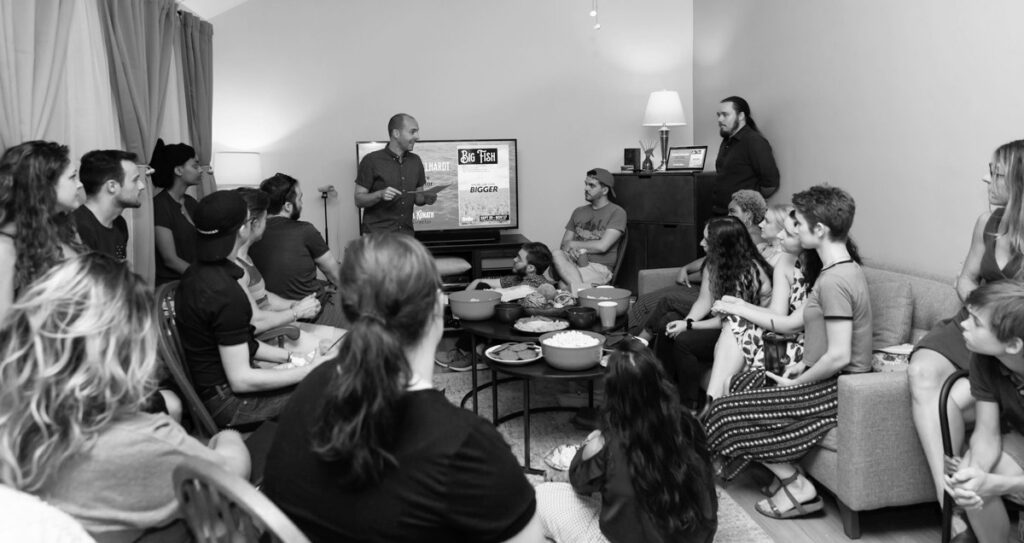“Whenever you’re not sure of what to do next, go back to the story,” BoHo Theatre’s final artistic director Elizabeth Swanson said, recalling predecessor Stephen Schellhardt’s motto as they faced a crumbling financial model at odds with company values. “Our stories contained everything we were aspiring to be. And when we couldn’t tell those stories anymore, it was time to go home.” Swanson’s voice betrayed a mournfully honest note. After nearly 20 years of producing theatre around Chicago, BoHo company members, “a family of pervasive kindness” as Swanson put it, have dispersed among the Chicago winds.
Swanson echoed a wider reckoning for artists in the Chicago storefront scene: The desire to tell beautiful stories is still there, but the funding to support fair and livable compensation is not. Operating out of rental venues and struggling to regain audiences post-pandemic, Chicago storefronts find themselves at a crossroads. In 2023 alone, First Folio Theatre, Sideshow Theatre Company, The New Coordinates, and Interrobang Theatre Project shuttered after grappling with these exacerbated issues. Chicago PR veteran David Rosenberg voiced concerns about whether these trends signify the non-Equity scene’s impending “obliteration” or a moment in which it could be revitalized in a communal call to action.

Born of a volunteer model, BoHo’s pre-pandemic days were not without their challenges. Executive director Sana Selemon pointed out that “every three to four years, someone in a higher administrative position would begin to feel very burnt out.” Over the years, company members would bring up the question of closure. Each time, though, someone would take it upon themselves to save the company, unpaid. “Really, my position was the first stipended position in the company, and then the artistic director, then our marketing director,” Selemon said. BoHo, which reported a budget of just over $50,000 in 2021, down from around $150,000 back in 2018, had hoped to answer calls for livable wages, thereby enabling people without a sustainable day job to work with the company. But there simply was no money to give. “We couldn’t afford an abundance mindset,” Swanson admitted.
“What we did was to create a sense of family with our casts, crews, designers, artistic team, and company members,” said Peter Marston Sullivan, a BoHo artistic director in the 2010s. “So I think that is how we were able to, frankly, not pay people very much money.”
Returning to in-person programming coincided with a much-needed conversation around pay equity and tangible diversity, equity, and inclusion integration, but it also brought with it higher materials costs and smaller budgets. “Do all that for less money,” Sullivan said, describing their dilemma. At a time when it’s absolutely clear that theatre workers need to innovate if we hope to recover—or, rather, better—our practice, he lamented that not every company has the agility or the bandwidth to radically pivot. “Evaluating the risk and reward is a challenge,” he said.

The company sought every avenue possible: fundraising, grant writing, possibly scaling back their season to just one musical per year, even merging with another nonprofit. Their first attempts discouraged them. For the 2022-23 season, Swanson said they raised every budget line connected to worker compensation, but still found their payments “unacceptably far below living wage.”
“Sustained development had never been in our company or board DNA,” she explained. “For most of its history, BoHo had operated largely on ticket sale proceeds. The company had a few folks giving generously, but we didn’t have a healthy donor base.”
“It’s hard to get a working board at BoHo’s level that actually goes out and raises money,” added Sullivan, who now serves as artistic director for the larger Marriott Theatre alongside some former BoHo members, including Selemon. “In spite of board exercises, board recruitment, and all kinds of classes, that didn’t happen. It was really about, how much are we going to lose on this show? I think it’s funny that, when Peter Blair was with me as executive director, our first show together made $24. And we just touted that everywhere, every chance we got. Subsequent ones lost a lot.”

As for cutting down their season or merging with another organization, Swanson said there were simply too many elements that needed to change for that to work. BoHo would have needed to implement a company restructure, build a new foundation for development practices, and continue building out the board, all while programming another season. There was a narrow path forward, but to follow it, Swanson said leadership staff was looking at 80-hour work weeks on a “10,000-a-year stipend.” Swanson realized that these options might delay the inevitable or potentially strip the company of its core identity. So before finally landing on closure, BoHo fought hard to reform its model.
“We had really started fundraising in a precise and clear manner,” Selemon said. “At the beginning of the pandemic, we did add on a financial consultant. I think there were building blocks that were potentially helping us become stable.”
However, soon after a January 2023 board retreat to strategize paths forward, it became clear that not only would the company be unable to meet its fundraising goals—it would also require far steeper ones, as a large sponsorship donation had fallen through.
Fin Coe, former co-artistic director of The New Coordinates, said he wishes that smaller companies were afforded clearer paths to survive. When TNC closed in May, Coe said grant organizations started reaching out more to offer pandemic relief opportunities. “But it was too late,” Coe said. “We fought tooth and nail to be recognized and funded by these organizations.” Without the safety net or passive revenue of larger houses, mere survival evolved into what Coe called an “increasingly brutal calculus.”
Looking ahead, creatives are taking comfort in efforts from local theatres to center their communities.
“There’s no better indicator of survival and success than being incredibly connected to your community,” Coe reflected after well-attended shows around Chicago at Raven Theatre and First Floor Theater. These companies, he celebrated, “know who they’re making their work for.”
“I don’t want to be getting back to normal,” Coe added, emphasizing the importance of not losing sight of the pay standards and accessibility for which artists have fought. “I want to get to better.”
At the Marriott, Selemon and Sullivan are striving to infuse their work with the human-centered values and care practices that BoHo instilled in them. Selemon still laughs with BoHo friends when inside jokes come up, but Sullivan observes the dwindling storefront landscape with a sigh, adding, “It is hard to lose another training ground for young artists.”
“It’s beautiful to see how BoHo formed lives and careers,” playwright and BoHo literary manager Dillon Chitto said. “It’s hard because, you know, I don’t wanna say that BoHo fulfilled its mission, but it did—BoHo did fulfill its mission. I still think it closed too soon. I’m just thinking about all the careers, all the lives it could have touched.”
As BoHo’s world premiere production of Valen-Marie Santos’s National Merit wrapped up last fall, Swanson was moved when various artists approached her, unprompted, to express their experiences at the theatre in superlative and healing terms. As BoHo itself closed, Swanson said their social media flooded “with stories of people who met through BoHo, who met their spouse or partner through BoHo, who had their first child while at the company, who stood in each other’s weddings.”
“I don’t quite know what to make of all this,” she said, struggling to reconcile the current deluge of closures, as well as the knowledge that BoHo tried but couldn’t innovate to support its artists. But, for now, they’ve found solace in that “some of it was worthwhile. It was worthwhile to those people.”
Gabriela Furtado Coutinho is the associate Chicago editor for American Theatre. gcoutinho@tcg.org


